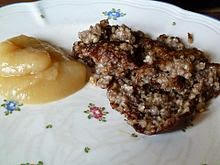 |
| A conventional log of Goetta |
Goetta is a breakfast sausage of likely German-American origin that is popular in the greater Cincinnati area. It is primarily composed of ground meat (pork, or pork and beef), pin-head oats and spices. Pronounced gétt-aa, ged-da or get-uh Americanized pronunciation, this dish probably originated with German settlers from the northwestern regions of Oldenburg, Hannover, and Westphalia who emigrated to the Cincinnati area in the 19th century. The word "Goetta" comes from the Low German word götte. North of Cincinnati, specifically in the region surrounding Mercer, Shelby, and Auglaize counties, goetta is often known by the term "grits", not to be confused with hominy grits. This usage of the word "grits" stems from the High German word "grütze," which is an equivalent of the Low German götte.
Goetta was originally a peasant dish, meant to stretch out servings of meat over several meals to conserve money.
Glier's Goetta, the largest commercial producer of goetta, produces more than 1,000,000 lb (450 metric tons) annually, around 99% of which is consumed locally in greater Cincinnati.
 |
| Goetta Links are being sold in Greater Cincinnati supermarkets |
While goetta comes in a variety of forms, all goetta is based around ground meat combined with pin head or steel cut oats. Usually goetta is made from pork shoulder or "Cali", but occasionally contains equal parts pork and beef. Goetta is typically flavored with bay leaves, rosemary, salt, pepper, and thyme. It contains onions and sometimes other vegetables.
While similar to scrapple in that it contains a grain product and meat for the purpose of stretching out the meat over several days, goetta looks very different. Scrapple is made with cornmeal while goetta uses steel-cut or chopped oats. The oats in goetta are much coarser than the fine powder used in scrapple and add texture to the dish.
Goetta is typically formed into small loaves, and then cut into squares and fried, often in the oil left over from browning the meats or in bacon drippings. Traditionally a breakfast food, goetta is often served with apple butter, ketchup, mustard, syrup, grape jelly, honey, or eaten by itself.
More recently, goetta has become an all purpose food eaten with any meal. New goetta products in the Cincinnati area include goetta burgers, goetta dogs, and goetta pizza. As the meat in goetta is precooked during the process of making the loaves, goetta can be kept in the freezer.
Due to the popularity of goetta in the Cincinnati metro area, a number of commercial distributors produce and sell it in the parts of Ohio, Kentucky, and Indiana near Cincinnati. The most popular of these brands is Glier's Goetta, the largest producer of goetta in the world. Glier's Goetta, established in 1946, is based in Covington, Kentucky, part of the greater Cincinnati area.
In the Greater Cincinnati area, there have been annual celebrations since 2004 with the central theme of Goetta.
The "Original Goettafest" is an annual cultural and culinary celebration held in Covington, Kentucky, just across the river from Cincinnati, Ohio. Covington has a rich heritage of German immigrants and this festival is held in MainStrasse Village, an area of Covington a few blocks from the Ohio River. In 2006, this celebration was held June 17 and 18.
"Glier's Goettafest" is a similar event held near Newport, Kentucky's "Newport on the Levee"(an entertainment, shopping and restaurant complex) on the Ohio River waterfront. The festival celebrates both the dish and Greater Cincinnati's German American heritage. While the main focus of the festival is goetta, served in many different ways, it also typically includes music, dancing, and other public entertainment. In 2013, the festival was held August 1 through 4.
 | |
| A plate of pan-fried Knipp with apple sauce |
Glier's markets Goetta as the "German Breakfast Sausage", creating the wrong impression that it is something commonly eaten for breakfast in Germany. In fact the vast majority of Germans have never heard of Goetta. However, an equivalent food known as Knipp can be found in the present day in Bremen and surrounding areas. This can be found spread onto bread or pan fried like goetta. It is also often served with apple sauce paralleling the apple butter which is served alongside goetta. Although in modern times in most parts of Germany, eating warm sausage for breakfast or a hot breakfast in general is not common, historically Knipp was eaten for breakfast, often in the winter.
Glier's Goetta
THIS IS GOETTA.
The patties begin to sizzle. The pin oats swell and pop. The spices throughout the gloriously married pork and beef infuse the atmosphere. And the corners of your brain turn up to a grin. While the crumbles dance in the hot pan, the rounds color to a golden brown, and your tongue puddles with anticipation. The final patty is flipped unveiling a brilliant batch of toasted treasures. The belly roars.
THIS IS GOETTA.
Your fork breaks the delicate crisp and moves carefully through the creamy middle of the morning circle. Every bite sends you deeper into total sensory engagement, and allows the mind to skip through the collection of stories that decorate your family’s history and your own. In a moment you are at your grandma’s counter enveloped in tales of her grandma’s kitchen. Your heart sings.
THIS IS GOETTA.
The pure enjoyment you draw from each tender-crisp forkful testifies to the power of passion. Your delight drives that passion. And the contribution of your experience makes richer the fabric that forms the heritage and legend. This is the end of boring breakfast. This is the return to what matters. The return to what inspires. The return to what is right and good and real and delicious.
THIS IS GOETTA.
www.goettacom.

No comments:
Post a Comment